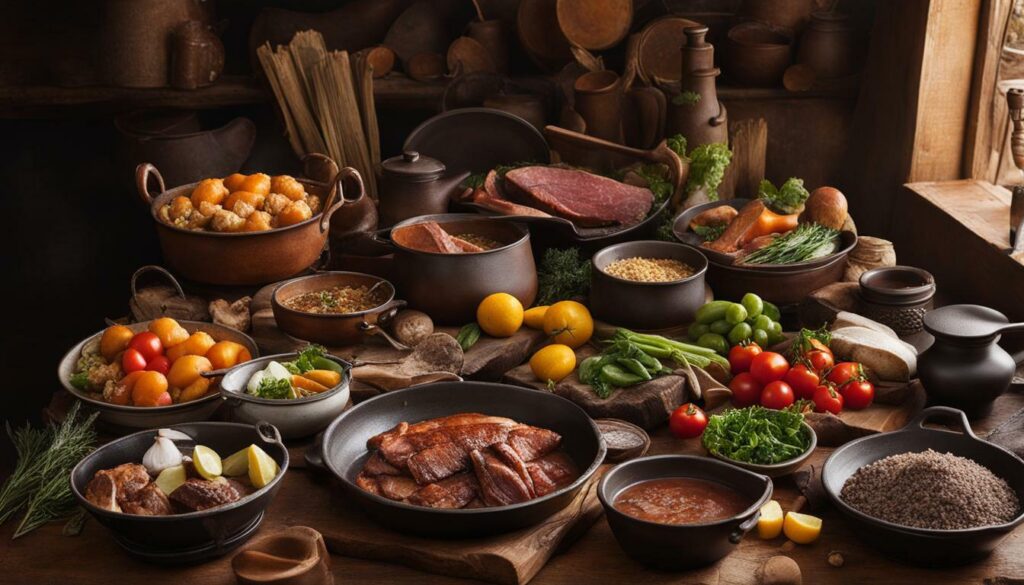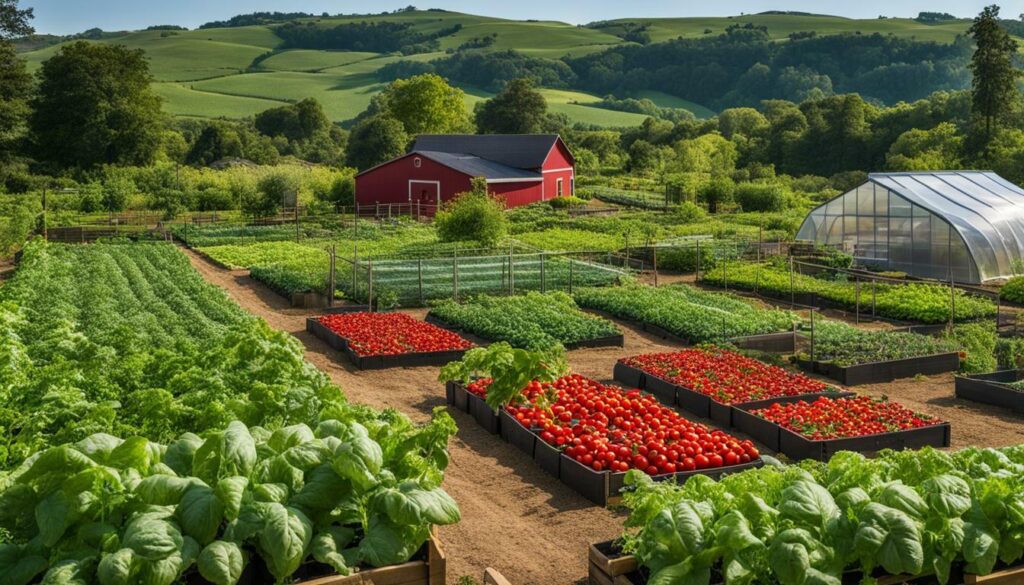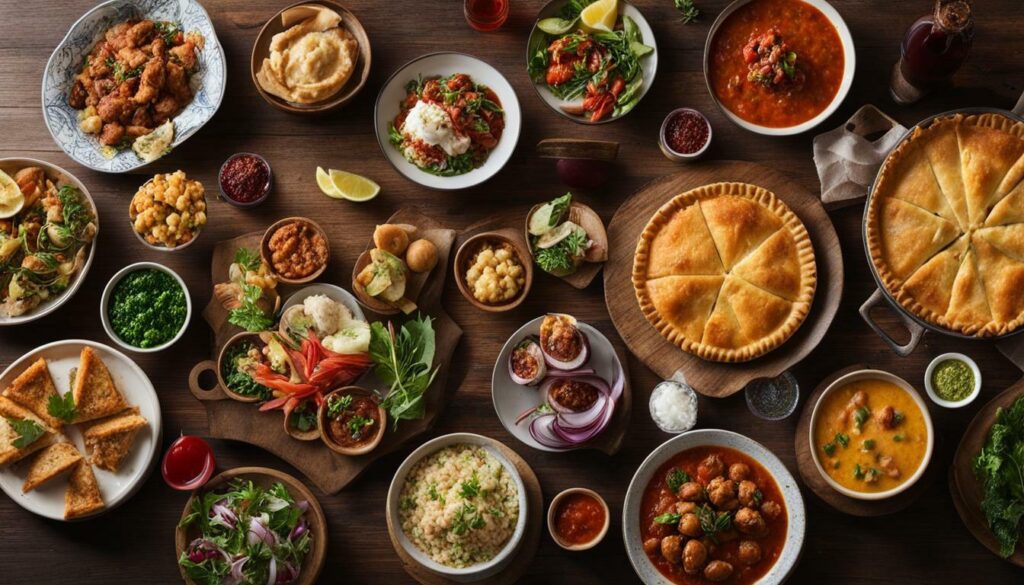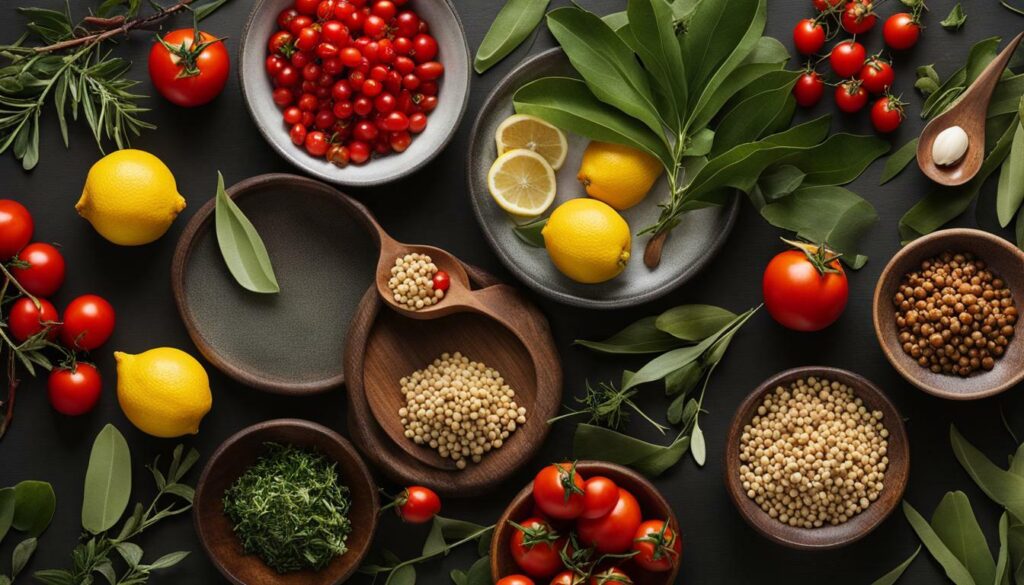Australia’s rich food history and diverse culture have shaped its past and present diets, making it a fascinating journey to explore the culinary traditions of this continent. From traditional Australian foods to festive delicacies and cuisine diversity across regions, the country offers a vibrant tapestry of flavours and dishes.
Key Takeaways
- Australia’s past and present diets reflect its rich food history and diverse culture.
- The last decade has seen a shift towards cafes as popular dining destinations and the emergence of pubs as places to enjoy meals.
- The history of meat consumption in Australia showcases the hunting practices of indigenous Australians and the introduction of meat-eating culture by European colonizers.
- Attitudes towards meat are gradually changing, with a growing number of Australians identifying as meat reducers or flexitarians.
- Sustainability and health considerations are now being incorporated into dietary guidelines, emphasizing the need for balanced and environmentally conscious food choices.
Changes in Australian Eating Habits over the Past Decade
Over the past decade, Australia has witnessed notable changes in its eating habits, with a growing interest in visiting cafes and a noticeable shift towards enjoying meals at pubs. Australians have embraced the cafe culture, seeking out trendy and cosy establishments to savour their morning coffee or indulge in a leisurely brunch. Cafes have become more than just a place to grab a quick bite – they serve as social hubs where friends gather, business meetings take place, and creative minds find inspiration. The rise of cafes as popular dining destinations reflects the changing preferences and lifestyles of Australians.
Furthermore, pubs have evolved into more than just drinking establishments. They have emerged as vibrant culinary destinations, attracting patrons with their contemporary menus and hearty meals. Australians now flock to pubs not only for their wide selection of beers and spirits but also to savour delicious dishes prepared by talented chefs. Pubs have become synonymous with good food, providing a relaxed and casual setting for people to unwind and enjoy a satisfying meal.
This shift in eating habits has been influenced by various factors, including changing work patterns, urbanization, and a desire for convenience. Australians are seeking out dining experiences that offer both quality food and an inviting atmosphere. The popularity of cafes and pubs as dining destinations reflects a cultural shift towards valuing experiences and community, where sharing a meal with loved ones or colleagues is seen as an opportunity to connect and create memories.

Famous Cafes and Pubs in Australia
- The Grounds of Alexandria – This iconic Sydney cafe is renowned for its beautiful garden setting, delectable brunch options, and specialty coffee.
- Lune Croissanterie – Located in Melbourne, this award-winning bakery is a must-visit for its flaky and buttery croissants, baked to perfection.
- The Pub with No Beer – Situated in Taylors Arm, New South Wales, this historic pub attracts visitors with its rustic charm and live music performances.
As Australians continue to embrace the evolving food scene, the future of dining in the country looks promising. From cafes that serve artisanal brews to pubs that redefine pub grub, Australia’s culinary landscape has become diverse, innovative, and exciting.
A Historical Perspective on Meat Consumption in Australia
Meat consumption has played a significant role in Australia’s dietary history, with indigenous Australians relying on hunting game and seafood, while European colonizers introduced a culture of meat-eating that became synonymous with social status. The availability of various species of wildlife allowed indigenous communities to sustain their livelihoods and nourish their bodies with valuable protein sources.
European colonization brought significant changes to the Australian diet. With the arrival of livestock, including sheep and cattle, meat became more accessible to settlers and gradually became a symbol of prosperity and prestige. The cultivation of crops and the establishment of agricultural practices further supported a growing meat-eating culture, shaping the nation’s culinary traditions.
Indigenous Australians have a rich history of hunting and gathering, incorporating a wide range of native animal species into their diets. European colonization brought about a significant shift, with meat consumption becoming a symbol of social status and prosperity.
The significance of meat in Australian diets has evolved over time, reflecting changing attitudes towards health, sustainability, and ethical considerations. As society becomes more conscious of the environmental impact of meat production and the health implications of excessive meat consumption, a growing number of Australians are adopting alternative dietary choices, such as reducing their meat intake or adopting flexitarian lifestyles.
The historical perspective on meat consumption in Australia provides valuable insights into the cultural and dietary transformations that have shaped the nation’s food habits. Understanding the roots of dietary traditions allows for a deeper appreciation of the diverse culinary landscape and the ongoing evolution of Australian cuisine.

This table provides an overview of the historical perspective on meat consumption in Australia:
| Period | Significance | Key Factors |
|---|---|---|
| Indigenous Era | Hunting game and seafood | Reliance on native animals for sustenance |
| Colonization | Social status and prosperity | Introduction of livestock and cultivation of crops |
| Modern Era | Changing attitudes towards health and sustainability | Rise of meat reducers and flexitarians |
Changing Attitudes Towards Meat in Australia
In recent years, attitudes towards meat consumption in Australia have been evolving, with a notable percentage of the population identifying as meat reducers or flexitarians, reflecting changing dietary perspectives. These individuals are consciously reducing their meat intake, either by choosing vegetarian or vegan options or by incorporating more plant-based meals into their diet while still occasionally consuming meat.
This shift can be attributed to various reasons, including concerns about animal welfare, environmental sustainability, and personal health. Many Australians are becoming more aware of the impact of meat production on the environment, such as deforestation, greenhouse gas emissions, and water pollution. They are also recognizing the health benefits associated with a more plant-focused diet, such as reduced risk of heart disease, obesity, and certain types of cancer.

These changing attitudes are reflected in the increasing availability of plant-based options in supermarkets, restaurants, and cafes across the country. Plant-based burgers, sausages, and other meat substitutes are gaining popularity, and there is a growing demand for plant-based protein sources such as tofu, tempeh, and legumes. This shift in consumer preferences is also influencing food companies to develop innovative plant-based products to cater to this growing market.
While meat consumption still holds cultural and social significance in Australia, the rise of meat reducers and flexitarians indicates a gradual shift towards more sustainable and balanced diets. It reflects a growing awareness of the interconnectedness between food choices, personal health, and the environment.
Incorporating Sustainability and Health into Dietary Guidelines
The importance of sustainability and health considerations in dietary guidelines has gained prominence in Australia, with increasing recognition of the need to make environmentally conscious food choices and improve overall well-being. As awareness grows about the impact of food production and consumption on the environment, individuals and policymakers are embracing the concept of sustainable diets that prioritize both ecological and nutritional factors.
One key aspect of incorporating sustainability into dietary guidelines is promoting the consumption of locally sourced and seasonal foods. By choosing locally grown produce, Australians can reduce the carbon footprint associated with long-distance transportation of food. Additionally, seasonal eating aligns with the natural cycles of food production and reduces the need for artificial interventions, such as extensive use of pesticides or refrigeration.

The Australian dietary guidelines also emphasize the importance of reducing food waste. By minimizing waste, individuals can contribute to reducing greenhouse gas emissions and conserve natural resources. Food waste not only squanders valuable resources used in production but also contributes to methane emissions in landfill sites. Simple steps such as meal planning, proper storage, and creative use of leftovers can help reduce food waste at the household level.
In terms of health considerations, the dietary guidelines in Australia encourage a balanced and varied diet that includes a range of foods from different food groups. This approach ensures individuals receive essential nutrients while minimizing the risk of chronic diseases. The guidelines highlight the importance of consuming fruits, vegetables, whole grains, lean proteins, and healthy fats, while limiting the intake of highly processed foods, added sugars, and unhealthy fats.
Overall, incorporating sustainability and health considerations into dietary guidelines is a crucial step towards creating a food system that is not only nourishing but also environmentally responsible. By making informed choices and embracing sustainable and healthy eating habits, Australians can contribute to a more resilient and sustainable future.
Festive Foods and Culinary Traditions in Australia
Festive foods and culinary traditions hold a special place in Australian culture, with a wide range of unique dishes and recipes that are cherished during celebrations and cultural events. From the iconic BBQs on Australia Day to the elaborate seafood spreads during Christmas, Australians take pride in their diverse culinary heritage.
One popular festive food in Australia is the traditional pavlova – a meringue-based dessert topped with fresh fruits such as strawberries, kiwi, and passionfruit. This light and sweet treat is a staple at Christmas gatherings and summer barbecues, offering a refreshing indulgence to beat the heat.

Another celebrated dish is the classic Aussie meat pie, a savoury pastry filled with minced meat and gravy. This comforting snack is often enjoyed at sporting events and family picnics, symbolizing the laid-back Australian lifestyle.
Cultural diversity in Australia is also reflected in its festive foods. For example, during the Muslim festival of Ramadan, the community comes together to break their fast with a feast known as iftar. Traditional dishes such as biryani, samosas, and baklava are shared among family and friends, highlighting the multicultural fabric of Australian society.
The Significance of Australian Meals
Australian meals are more than just a means of sustenance – they are a reflection of the country’s rich history and cultural diversity. From bush tucker to contemporary fusion cuisine, Australians embrace a wide variety of flavours and ingredients in their daily meals.
Meals often consist of a protein source such as grilled steak or barramundi, accompanied by a generous serving of fresh vegetables and a side of crispy chips. This combination provides a balanced and satisfying culinary experience that is enjoyed by locals and visitors alike.
Whether it’s a hearty breakfast of avocado toast and flat white coffee, a leisurely brunch with smashed avo and poached eggs, or a Sunday roast with all the trimmings, Australian meals bring people together and create lasting memories.
Cuisine Diversity Across Australia
Australia’s cuisine is a melting pot of diverse flavours and culinary traditions, with each region offering its own specialities, traditional foods, and typical dishes that reflect the country’s multicultural heritage. From the coastal regions with their abundant seafood to the inland areas known for their hearty bush tucker, Australian cuisine encompasses a wide range of tastes and influences. Indigenous ingredients such as kangaroo, emu, and native herbs and spices add an authentic touch to many dishes, while immigrant communities have brought their own culinary traditions, resulting in a vibrant and varied food scene.
The southern states of Victoria and Tasmania are famous for their seafood, with delicacies like abalone, crayfish, and oysters gracing the menus of coastal restaurants. In contrast, the tropical north showcases an array of exotic fruits, from mangoes and bananas to native favourites like finger lime. The rural areas of the Outback offer a taste of traditional Australian bush tucker, with dishes like kangaroo steaks and emu burgers becoming increasingly popular.
In addition to the regional specialities, Australian cities boast a rich multicultural food scene. Sydney, for example, is home to a thriving Chinatown, where visitors can indulge in authentic Chinese cuisine. Melbourne, known as Australia’s food capital, offers an eclectic mix of cuisines, from Italian trattorias to Greek tavernas, all reflecting the city’s diverse population. Adelaide is renowned for its wine regions, with cellar doors and restaurants offering a fusion of international flavours paired with local wines.

To truly experience the diversity of Australian cuisine, one must embrace the local food markets that can be found across the country. These markets are a treasure trove of fresh produce, artisanal products, and international street food stalls. From Queen Victoria Market in Melbourne to the Salamanca Market in Hobart, these bustling hubs provide a sensory feast and an opportunity to discover the unique flavours that make Australian cuisine so special.
In conclusion, Australian cuisine is a celebration of cultural diversity, blending indigenous ingredients, regional specialities, and global influences. Whether it’s enjoying a seafood feast by the coast, savouring bush tucker in the Outback, or exploring the cosmopolitan food scenes of Australia’s cities, there is something to satisfy every palate in this vast and flavorful country.
Traditional Australian Foods and National Identity
Traditional Australian foods have become an integral part of the nation’s identity, with certain dishes earning the status of national food and representing the rich culinary heritage of the country. These iconic dishes embody the fusion of indigenous Australian, European, and immigrant influences, resulting in a diverse and vibrant food culture.
One such dish is the famous meat pie, a savoury pastry filled with minced meat and gravy, often enjoyed at sporting events or as a quick meal. It is considered a staple of Australian cuisine and a symbol of the nation’s love for hearty and comforting fare. Another beloved dish is the legendary Vegemite, a spread made from yeast extract and packed with umami flavour. It is often slathered on toast or used as an ingredient in various recipes, and its strong and distinctive taste is a nostalgic reminder of childhood for many Australians.
Australia’s vast coastline also plays a significant role in its culinary identity, with seafood featuring prominently in traditional dishes. The classic Australian prawn cocktail is a popular starter, showcasing succulent prawns served with tangy cocktail sauce and crisp lettuce. Additionally, the barbecued snags, or sausages, are a staple at gatherings and represent the nation’s love for outdoor cooking.
The diverse culinary landscape of Australia is also reflected in its regional specialities.
In the tropical north, Indigenous bush tucker such as kangaroo, emu, and native fruits like quandong and finger lime are celebrated for their unique flavours and connection to the land. In the southern regions, hearty dishes like the slow-cooked lamb roast and the traditional Damper bread baked over a campfire pay homage to the pioneering era. The multicultural cities of Sydney and Melbourne boast vibrant food scenes with influences from around the world, offering a wide array of international cuisines alongside the traditional Australian fare.

| Traditional Australian Foods | Region |
|---|---|
| Lamington | Queensland |
| Barramundi | Northern Territory |
| Chiko Roll | New South Wales |
| Golden Gaytime | Victoria |
| West Australian Rock Lobster | Western Australia |
These traditional Australian foods not only satisfy appetites but also serve as cultural touchstones, preserving the stories and traditions of generations past. They bring communities together, celebrate diversity, and create a sense of national pride. As Australia continues to evolve, these cherished dishes remain a delicious reminder of the country’s culinary heritage.
The Significance of Australian Meals
Australian meals hold great significance in the country’s social fabric, representing a time for families and friends to come together and share delicious dishes that showcase the flavours of the nation. From hearty breakfasts to light lunches and elaborate dinners, Australian cuisine encompasses a diverse range of culinary traditions and influences.
Typical foods of Australia, such as meat pies, lamingtons, and Vegemite, are iconic symbols of the country’s food culture. These dishes reflect the fusion of indigenous ingredients and cooking methods with European flavours brought by early settlers. Australian meals are often characterized by a harmonious blend of fresh seafood, succulent meats, vibrant fruits, and seasonal vegetables.
With its rich agricultural landscape, Australia offers an abundance of fresh produce that forms the foundation of its cuisine. From native ingredients like macadamia nuts and kangaroo meat to international imports like Asian spices and Mediterranean herbs, the culinary landscape of Australia is a melting pot of flavours.

Whether it’s enjoying a traditional Aussie barbeque on a sunny day or indulging in a pavlova dessert during festive celebrations, Australian meals evoke a sense of togetherness and pride in the country’s culinary heritage. The combination of diverse flavours and the laid-back Australian lifestyle makes every meal an occasion to savour and celebrate.
Preserving and Promoting Australian Culinary Heritage
Preserving and promoting Australian culinary heritage is essential to safeguarding the nation’s rich food traditions, with various initiatives and organizations working diligently to ensure the preservation of traditional foods and recipes. Australia’s diverse culinary landscape is deeply rooted in its history and cultural heritage, with a melting pot of influences from Indigenous Australians, European settlers, and more recent immigrants. It is through the conservation and celebration of these culinary traditions that future generations can continue to appreciate and enjoy the unique flavours and stories that define Australian cuisine.
One notable initiative in the preservation of traditional Australian foods is the Australian Native Food and Botanicals (ANFAB) organization. ANFAB aims to promote the use of native Australian ingredients, such as kangaroo, emu, wattleseed, and bush tomatoes, in contemporary cooking. By collaborating with chefs, producers, and researchers, ANFAB raises awareness about the cultural and ecological significance of these ingredients and encourages their incorporation into modern recipes and menus.
The Australian Heritage Cookbook is another valuable resource for preserving traditional Australian recipes. This comprehensive collection showcases the diverse range of dishes from different regions of Australia, including iconic favourites like meat pies, damper, and pavlova. The cookbook serves as a testament to the importance of passing down culinary knowledge and encourages home cooks and professional chefs alike to explore and rediscover the classic recipes that have shaped Australian cuisine.

In addition to these initiatives, festivals and events across Australia celebrate the country’s rich food heritage. For example, the annual Tasting Australia festival brings together acclaimed chefs, producers, and food enthusiasts to showcase the best of Australian cuisine. With a focus on regional flavours and sustainable practices, the festival highlights the importance of local produce and traditional cooking methods.
By preserving and promoting Australian culinary heritage, we can ensure that the stories and flavours of the past continue to thrive in the present and future. Through the efforts of organizations, cookbooks, and events, traditional Australian foods and recipes can be appreciated and enjoyed by both Australians and visitors from around the world, contributing to the country’s vibrant and diverse food culture.
Conclusion
In conclusion, the past and present diets of Australia showcase a captivating journey through its rich food history, highlighting shifts in eating habits, changing attitudes towards meat, the inclusion of sustainability and health considerations, festive foods and culinary traditions, cuisine diversity, the connection between traditional foods and national identity, the significance of Australian meals, and the importance of preserving and promoting culinary heritage.
Over the past decade, Australians have witnessed a significant transformation in their eating habits. Cafes have become increasingly popular as dining destinations, offering a wide range of culinary experiences. At the same time, pubs have emerged as places not only for socializing but also for enjoying delicious meals. This shift reflects the changing preferences and lifestyles of Australians, who seek diverse and convenient dining options.
The history of meat consumption in Australia provides insights into the cultural dynamics of the nation. Indigenous Australians traditionally hunted game and seafood as part of their diets, while European colonizers introduced a meat-eating culture associated with social status and prosperity. However, attitudes towards meat are gradually evolving. A growing number of Australians identify as meat reducers or flexitarians, recognizing the importance of balancing their diets with plant-based alternatives for both health and environmental reasons.
The inclusion of sustainability and health considerations in Australia’s dietary guidelines reflects a changing mindset towards food choices. Recognizing the impact of food production on the environment, guidelines now emphasize the importance of incorporating sustainability into daily eating habits. Additionally, there is a growing recognition of the need for balanced and nutritious diets to support overall health and well-being.
Australia’s festive foods and culinary traditions offer a unique glimpse into the country’s cultural diversity. From traditional dishes associated with cultural celebrations to modern interpretations of Australian cuisine, these culinary delights reflect the country’s multicultural heritage. Australians take pride in their diverse culinary landscape, showcasing a fusion of flavours and culinary techniques from around the world.
The cuisine diversity across Australia is a testament to the country’s vibrant and multicultural society. Each region boasts its own specialities and traditional foods, contributing to a rich tapestry of flavours and culinary experiences. From fresh seafood along the coast to hearty meat dishes in the outback, Australian cuisine encompasses a wide range of flavours and culinary traditions.
Traditional Australian foods hold a special place in the country’s national identity. From the iconic meat pie to the beloved Lamington, these dishes have become synonymous with Australia’s culinary heritage. They evoke a sense of nostalgia and pride, representing the unique blend of cultures and traditions that have shaped Australian cuisine.
Australian meals are not merely a means of sustenance but a social and cultural aspect of daily life. Gathering together to enjoy a meal is a cherished tradition, fostering connections and shared experiences. From barbecues in the park to Sunday roasts at home, Australian meals bring people together and create lasting memories.
Preserving and promoting Australian culinary heritage is crucial in maintaining the country’s food traditions. Initiatives and organizations dedicated to safeguarding traditional foods and recipes ensure that they are celebrated and passed down to future generations. By preserving and promoting culinary heritage, Australians can continue to appreciate the richness of their food history and the unique flavours that define their national cuisine.
FAQ
What changes have occurred in eating habits in Australia over the past decade?
Over the past decade, there has been an increasing interest in visiting cafes and a shift towards eating at pubs in Australia.
What is the history of meat consumption in Australia?
Indigenous Australians traditionally hunted game and seafood, while European colonizers introduced a meat-eating culture associated with social status.
How are attitudes towards meat changing in Australia?
There is a gradual shift in attitudes towards meat in Australia, with a percentage of the population identifying as meat reducers or flexitarians.
How are sustainability and health considerations being incorporated into dietary guidelines in Australia?
There is a growing recognition of the need to incorporate environmental factors into dietary choices, with a range of references related to sustainable and healthy diets being included in dietary guidelines.
Source Links
- https://www.ncbi.nlm.nih.gov/pmc/articles/PMC9583557/
- https://www.ausfoodnews.com.au/2017/03/20/the-evolution-of-australias-eating-habits-roy-morgan-research.html
- https://www.frontiersin.org/articles/10.3389/fsufs.2021.624288



